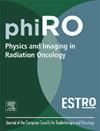Prospective validation of a pretreatment 18F-FDG PET/CT and mean lung dose model for early radiation pneumonitis
IF 3.3
Q2 ONCOLOGY
引用次数: 0
Abstract
Background and purpose
Early onset radiation pneumonitis (RPEarly) after concurrent chemoradiotherapy (cCRT) can lead to consolidation immunotherapy (IO) discontinuation, and poor survival in locally advanced non-small cell lung cancer (LA-NSCLC). This work assessed the external validity of a previously published RPEarly risk model.
Material and methods
The RPEarly risk model utilizes pretreatment 18F-FDG PET/CT imaging of the normal lungs and the mean lung dose (MLD). The 90th percentile of the standardized uptake value (SUVP90) and the MLD model parameters from the previous derivation cohort (N = 160) were applied in the independent cohort (50 consecutive LA-NSCLC patients treated with cCRT and IO) where model performance was evaluated (area under the receiver-operating characteristic curve (AUC), p-values, and the Hosmer-Lemeshow test (pHL)).
Results
Seven patients (14 %) developed RPEarly. Model performance of the previously developed SUVP90 and MLD model improved with re-fitting (AUC = 0.76 vs. 0.72; p = 0.01 vs. 0.10; pHL = 0.66 vs. 0.94). Above a clinically desirable 10 % predicted RPEarly, after refitting model coefficients in the combined derivation and validation cohorts (N = 210), the MLD was 13 ± 2.2 EQD23 Gy (SUVP90 = 1.2 ± 0.3) above the RPEarly risk threshold vs. 8.5 ± 2.6 EQD23 Gy (0.9 ± 0.2) below the threshold. For an SUVP90 of 1.1 and an MLD of 11 Gy EQD23 Gy, 25/27 patients developing RPEarly were captured.
Conclusion
The previously developed SUVP90 and MLD-based risk model for RPEarly demonstrated a high probability to correctly predict RPEarly in the independent cohort. This now validated RPEarly risk model with derived high-risk indications could enable personalized thoracic RT planning to reduce the risk of RPEarly and of discontinuing life-prolonging IO post-cCRT.

18F-FDG预处理PET/CT和平均肺剂量模型对早期放射性肺炎的前瞻性验证
背景和目的同步放化疗(cCRT)后早发性放射性肺炎(RPEarly)可导致局部晚期非小细胞肺癌(LA-NSCLC)的巩固免疫治疗(IO)中断和生存率低。这项工作评估了先前发表的RPEarly风险模型的外部有效性。材料和方法RPEarly risk模型采用预处理的18F-FDG PET/CT正常肺成像和平均肺剂量(MLD)。在独立队列(50例连续接受cCRT和IO治疗的LA-NSCLC患者)中,采用标准化摄取值(SUVP90)的第90百分位和先前衍生队列(N = 160)的MLD模型参数,评估模型性能(接受者-工作特征曲线下面积(AUC)、p值和Hosmer-Lemeshow检验(pHL))。结果早期发病7例(14%)。先前开发的SUVP90和MLD模型的模型性能通过重新拟合得到改善(AUC = 0.76 vs. 0.72; p = 0.01 vs. 0.10; pHL = 0.66 vs. 0.94)。在推导和验证联合队列(N = 210)中修正模型系数后,在临床所需的10%以上预测RPEarly, MLD比RPEarly风险阈值高13±2.2 EQD23 Gy (SUVP90 = 1.2±0.3),比阈值低8.5±2.6 EQD23 Gy(0.9±0.2)。SUVP90为1.1,MLD为11 Gy EQD23 Gy,捕获了25/27的早期发展患者。结论先前建立的基于SUVP90和mld的RPEarly风险模型在独立队列中正确预测RPEarly的概率很高。现在,这个经过验证的RPEarly风险模型及其衍生的高风险适应症可以实现个性化的胸部RT计划,以降低RPEarly的风险和ccrt后停止延长生命的IO的风险。
本文章由计算机程序翻译,如有差异,请以英文原文为准。
求助全文
约1分钟内获得全文
求助全文
来源期刊

Physics and Imaging in Radiation Oncology
Physics and Astronomy-Radiation
CiteScore
5.30
自引率
18.90%
发文量
93
审稿时长
6 weeks
 求助内容:
求助内容: 应助结果提醒方式:
应助结果提醒方式:


